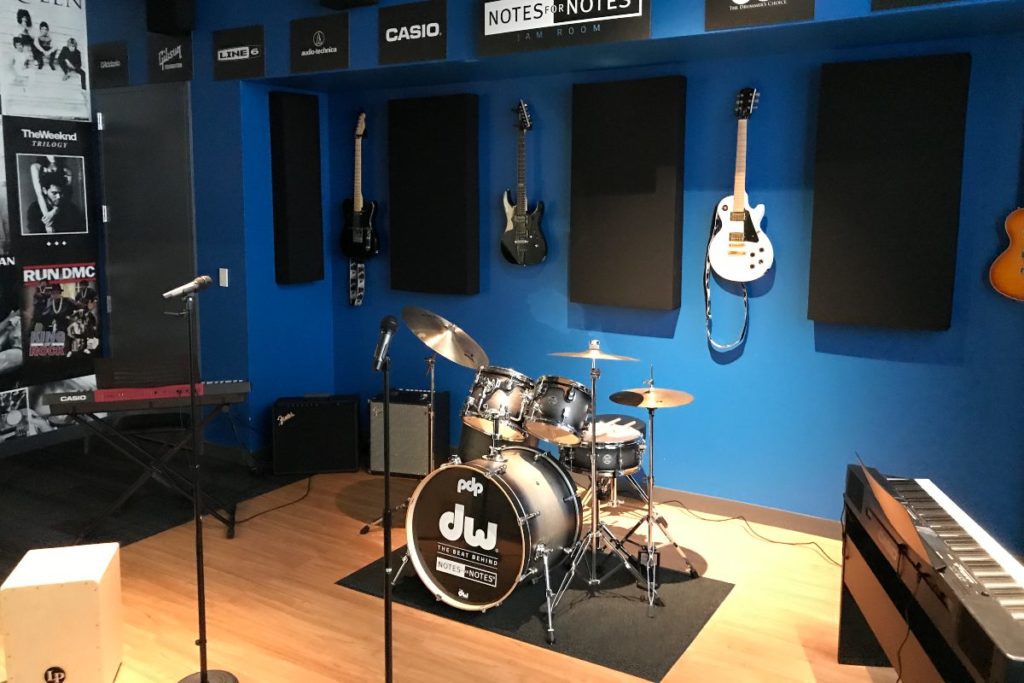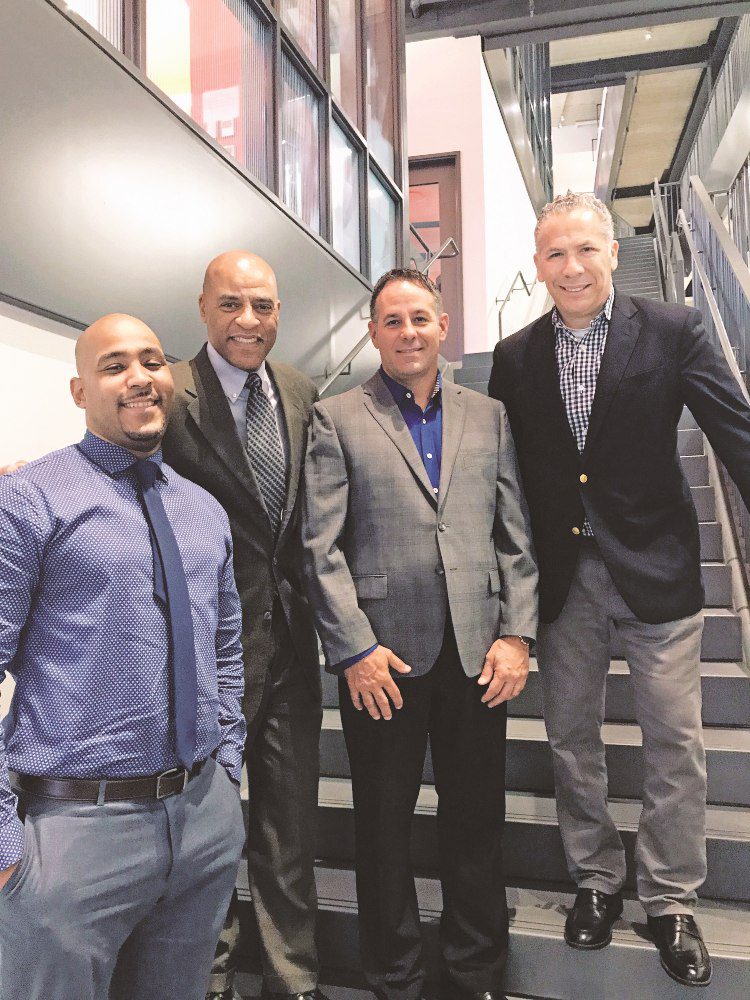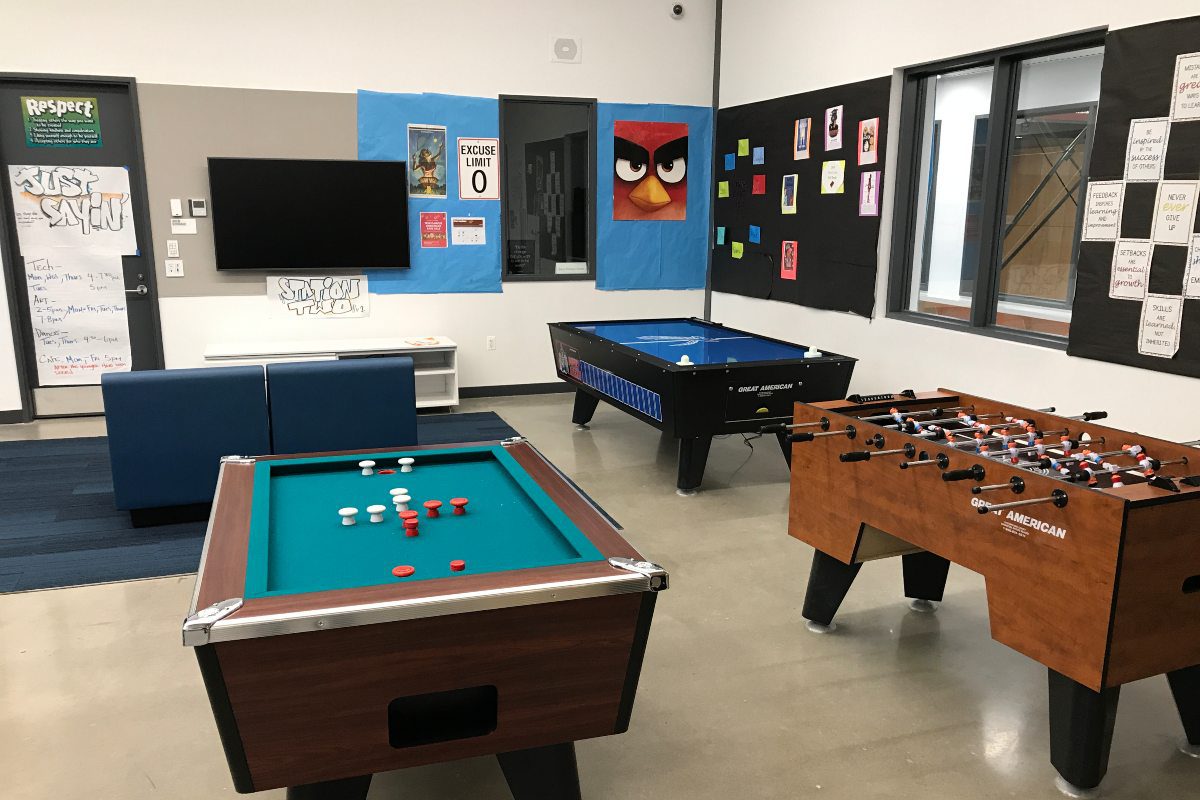Of all of the projects Mike DeMello has completed over the past 22 years as an integrator, this might be his proudest achievement. DeMello, president of AV Design & Integration n Valhalla, N.Y., and his team spent 18 months integrating $1 million worth of technology for the Madison Square Boys & Girls Club of America in Harlem. The three-story, 45,000-square-foot facility is a haven for more than 700 underprivileged kids to escape the mayhem of the New York City neighborhood where they can play, build friendships, and even potentially learn lifelong technical skills.
The facility is an oasis in the heart of the Harlem, where gangs and other influences routinely can ensnare youths into unsavory activity. With a modern design that shimmers in blue and gray, the sparkling facility sits in the shadow of a rusty elevated train line near 155th Street, directly across the street from high-rise public housing that sits on the site of the old Polo Grounds ballpark where the New York Giants baseball team played. After five years of fundraising and planning and two years of construction, the Club opened in July 2019.
AV Design & Integration outfitted 17 unique interior spaces and the entire structure with an array of displays, projectors and screens, touchscreens, a wireless and hardwired network, audio, and security equipment. Some of the interior spaces in the $45 million facility include an education room, 3D printer room, podcast room, music studio, gaming area, teen lounge, performing arts area, movie screening room, full-court gymnasium and a rooftop soccer field.
Quick Stats:
COMPANY: AV Design & Integration
LOCATION: Valhalla, N.Y.
REVENUES (2019): $6 million
YEARS IN BUSINESS: 22
NUMBER OF EMPLOYEES: 20
SPECIALTIES: High-end residential, commercial and government
KEY BRANDS: Crestron, Sony, Lutron, Samsung, Savant, Control4
FYI (ADVICE TO OTHER INTEGRATORS): “If you want to do well in the custom integration industry: plan, plan, plan, plan, plan, plan, and then perform.”
The results have been beyond expectations as kids ages 6 to 18 flock to the facility every day to play sports, play instruments, create their podcasts, watch movies, paint and draw illustrations, train in cosmetology, or just read and study. Only about 200 kids were expected to become members, but 713 have become members, according to Jason Garcia, clubhouse director.
“We designed this facility based on the needs of young people,” says Steve Melton, COO of the Madison Square Boys & Girls Club. “We wanted to set up this building so it was very kid-friendly. It had to be beautiful; it had to be different, it had to be modern. We had to show the community that we cared and were committed.”
Technology Plays Crucial Role in Modern Facility
In addition to the arts, theater and athletics, Melton says the technology component is vital.
“Technology is everything to kids today. You can’t get away from it. When young people come into this facility, it’s important for them to see video screens and have wireless capabilities. The Technology Room here does not have desktop computers, but uses laptops instead. We have audio that plays throughout the building.”
Garcia adds, “Having the technology gives kids the opportunity to have an upper hand. Most of the kids do not have technology at home. Th is is an opportunity for them to come here and take advantage of the technology.”
The important role AV Design & Integration played in the facility was not lost on DeMello and his entire staff.
“The real interesting thing is just giving back to the community,” says DeMello. “I grew up in a small town in lower Westchester called Mount Vernon. It’s similar to a Bronx feel. We didn’t have this sort of stuff growing up. Our version of it was, ‘Go outside and ride your bicycle’ or ‘Go play hide and seek.’ We had no real community center like this.”

Initially, DeMello says the sheer size of the project is what piqued his interest, but then as the project matured, he recognized the importance of what was being created for the underprivileged kids in the community.
“It meant a lot not only to myself, but to the entire company — it really did,” he says. “There are many instances where we work on a project and there’s great satisfaction when you finish it and the customer loves it. At the Madison Square Club, the ultimate ‘customers’ don’t know us … the customers are these kids that are experiencing the technology. They live in little apartments or they come from single-parent families where the stress level for younger children is much higher.”
He continues, “This project really meant a lot to everybody in our company, from the project managers to the technicians. It is unbelievable that a kid is going to experience something like a 70-inch Planar touchscreen to be able to learn on — and some of these kids don’t even have a television at home. It was spine-tingling during the grand opening and we got to see hundreds of kids here. It was a great satisfaction for us to really see the project finished and how it works within the community.”
Richard Hollander, AV Design & Integration’s director of business development, agrees.
“This place allows children to have extensive technology interaction, and that will eventually lead to something very positive. This Club is ‘The Wizard of Oz’ to me … it’s an oasis. It’s an opportunity for these kids to develop real technology skillsets that give them real leadership skills that they can use in the world when they walk out of here. To me, that’s everything — this place is special,” he gushes.
Taking on a $1M Commercial Project
There are not many integration companies that can comfortably cater to ultra-wealthy clients in Manhattan and the Hamptons, while also working with a non-profit organization on a large commercial project like Madison Square. But AV Design & Integration is no ordinary firm.
With 20 employees and offices in both New York and Pompano Beach, Fla., the company will earn more than $6 million in revenue in 2019 via a diverse combination of residential, commercial and even government work. AV Design & Integration was originally brought to the project by the developer, T.G. Nickel & Associates.
“We had done a couple of projects with them before,” says DeMello. “They knew that we are capable of handling a project like this.” AV Design & Integration was working off a set of design specs done by Cerami, a Manhattan-based technology design and engineering firm.

“We went through the drawings and gave them estimations on the budget and we were awarded the project,” DeMello recalls. At that point, the team had to put pencil to paper knowing that the Madison Square Boys & Girls Club is a non-profit entity.
“It was designed to be built to the best magnitude. We had to scale back on a few things and change a few design elements. We pulled a few things out, moved the location of a few doors and windows where we could, and added a few things that make the building work better,” says DeMello.
For example, the access control portion of the security system was completely redesigned, to include a set of Lenel turnstiles in the lobby. The surveillance cameras are a combination of Exacq Vision and Axis Communications.
The entire facility is connected with a fiber infrastructure and supports the building’s network, which was provided by the Madison Square Club’s network vendor based on configurations outlined by AV Design & Integration.
There are several Crestron systems in the facility, some standalone and some grouped together, including quite a few Crestron presentation systems controlled by Crestron touchpanels and keypads. A Barco ClickShare system is in place through the Club to allow guests to book various rooms. It also generates a report for the Madison Square team to monitor system usage.
“It’s super easy to use. It’s a quick software download, you walk over to the device you literally just push the button, it clicks and then you can connect to it. That’s the reason it’s called ClickShare, you can share your screen from your phone, from your iPad, from a PC, from a laptop or a Mac,” explains DeMello.
The lighting system is from Lutron with dimming modules and occupancy sensors throughout controlled by Lutron seeTouch keypads.
The projectors in the gymnasium, screening room and in various meeting rooms are from Christie Digital. The loudspeakers are mix, including commercial-grade JBL Pro in the gym, dance room and screening room.
Challenges Include Scale, Heights
The project presented several challenges, including very-high scaffolding work in the massive gymnasium. The AV Design crew had to erect large-scale scaffolding to reach the 100-foot-high steel beams on the ceiling in the indoor soccer field to install 360-degree surveillance cameras and loudspeakers.
In the gymnasium, technicians had to use a scissor lift to reach the ceiling and walls. Since the weight of the lift could damage the hardwood floor, the AV Design team had to fully complete the installation before the floor was installed.
Wisely, every technician at the company is OSHA certified, and most are scaffold certified, according to DeMello. That was vital since the ceiling height in nearly every room in the facility is also quite high, requiring technicians to be on 12-foot ladders.
“When you get into a commercial project of this level, it’s quite a bit different than a residential. There are more restrictions, you have to wear hardhats, vests, and steel-toed boots. Compare that to a typical residential job where you are wearing sneakers and no one cares. It’s a different environment,” he notes.
The sheer scale of the project was also a challenge.
“Project management for a commercial job versus residential is a different animal. The project manager really has to make sure the team understands what’s required of them when they show up on site. In terms of manpower, we probably had a crew of about eight guys do the pre-wire,” he says.
The open design in the Club made wiring a bit tricky, so AV Design laid it out so that all its main distribution frames (MDFs) and intermediate distribution frames (IDFs) are on one side of the building to reduce costs and installation time.
“All the wiring is sleeved from one floor to the other floor. Running the wires and getting things vertically done was a breeze because we had a lot of input early on,” DeMello says.
For example, the speakers and cameras that were installed high on the ceiling in the gymnasium and soccer field could not just be prewired. The devices had to be installed while the scaffolds and lift were in place 40 feet in the air.
“You can’t just go back on a ladder and test the device later,” quips DeMello. “Those were the challenges that we faced.”
As always seems to be the norm in large projects, the construction process was constantly behind schedule and the AV Design staff had short notice on when certain rooms were ready for them.
“It was very fast-paced,” adds DeMello.
Diversifying with Commercial, Government Jobs
DeMello started AV Design & Integration 22 years ago after working for a high-end car stereo installation firm for many years right out of high school. When he launched his own company, car stereo was part of the mix but soon he focused solely on home entertainment. The recession in 2008 changed that.
“Until the crash in 2008, we were 100% residential and did a 50/50 split of new construction versus retrofit,” DeMello recalls. The company has always had its hand in security, and even today security is a key part of its packaged offerings.
“After 2008, I realized that I had to get rid of some of the cyclical nature of the business, so I had to do commercial and government work. That led me to explore one commercial project after another and today we are 60% residential/40% commercial. We don’t do a lot of commercial projects, but the ones we do are big ones,” he explains.
“Back in 2008, 2009 and 2010, I noticed that large commercial projects still went on despite the recession. Other integrators who were only doing residential work were desperate to find new business, but we discovered many of those commercial jobs still carried on. That led to government projects, which are mostly required to be done. It’s not a question of ‘if’ a government project will get done, it’s a question of ‘when.’ They have to get done.”
AV Design & Integration has done projects for the City of New York, the mayor of Yonkers and even the U.S. Immigration and Customs Enforcement (ICE) agency.
The business is structured so that engineering, sales and operations are proficient in all three areas: residential, commercial and government. DeMello is involved in many of the larger sales, while key personnel like industry veteran Hollander are also integral at the sales level.
“Whether you’re buying a flat-screen TV for a commercial job or you’re buying a flat-screen TV for a residential, it’s the same thing. It doesn’t matter,” DeMello says.
“The installation challenges are a little different but the parts and the pieces and the structure of it are all pretty similar. The bigger difference is the contracts for commercial are very different than residential. Most integrators like residential work because they get paid upfront most of the time. When you’re doing a large-scale commercial project, a lot of the funding is coming from your pocket initially and you get paid on the back end. That’s the biggest difference … the rest of it’s all pretty straightforward.”
The company’s residential work runs the gamut from multimillion-dollar penthouses in Manhattan and ritzy estates in the Hamptons to simple TV installations.
“I decided a long time ago that for the right customer, no job was too small for the business. I have customers from when I started 22 years ago. If they call and ask to have a TV swapped out in the family room, I have no problem doing that,” he says.
“It’s really all about the customer experience. Do we fit the customer? Does the customer fit us? Can we work well together? That’s really what it comes down to.”
Building an RMR Model
With DeMello’s experience in security, it’s no surprise that AV Design & Integration has a recurring monthly revenue (RMR) business model.
“I think consumer electronics integration companies early on did a disservice to the customer. They sold expensive Crestron systems and Savant systems to clients but never really explained to the customer that these are complex systems that require maintenance and firmware updates,” he comments.
To that end, the company spends a great deal of time educating architects, designers and clients that those expensive home control systems are not “bad,” but the customers didn’t understand that service was going to be required when they bought this system.
“We use the car analogy a lot,” DeMello says. “When buy your first car as a young kid, you might not know that you’re going to need to buy tires because they wear out, or that the car will need new brakes at some point. Well, in our business, no one discusses that with the customer. They just say, ‘Here’s a bill for a service call for $4,000. We had to update your firmware and we had to fix a few things.’ That leaves a bad taste in the customer’s mouth. We are spending a lot of time educating clients that when they buy a system, they are buying our company long term to service and maintain it. We are not going to walk away.”
The company’s service program gives every client a two-year warranty on labor from day one. Then clients can choose three-, four- or five-year service plans. The programs are selling very well among new customers, primarily because the AV Design team now emphasizes it. The three- and four-year service agreements are based on 10% of the price paid for the equipment on the project. For remote service, DeMello relies on Panamax BlueBOLT and SnapAV OvrC.







